Geochemical Evaluation of the Cretaceous Mudrocks and Sandstones (Wackes) in the Southern Bredasdorp Basin, Offshore South Africa: Implications for Hydrocarbon Potential
Abstract
:1. Introduction
2. Geological Setting
3. Methodology
3.1. Materials
3.2. Total Organic Carbon Content (TOC)
3.3. Rock-Eval Pyrolysis
3.4. Vitrinite Reflectance (RO)
4. Results and Discussion
4.1. Total Organic Carbon (TOC) Content
4.2. Quality and Type of Kerogen
4.3. Thermal Maturity Level
4.4. Hydrocarbon Generation Potential
5. Conclusions
Supplementary Materials
Author Contributions
Funding
Acknowledgments
Conflicts of Interest
References
- Petroleum Agency South Africa, PASA. Petroleum Exploration in South Africa, Information and Opportunities; Online Report; PASA: Cape Town, South Africa, 2012; pp. 25–29. Available online: http://www.petroleumagencysa.com/images/pdfs/pet_expl_opp_2012fw.pdf (accessed on 17 November 2019).
- Petroleum Agency South Africa. Petroleum Exploration Information and Opportunities: Petroleum Agency of South Africa Brochure; Petroleum Agency South Africa: Cape Town, South Africa, 2003; pp. 12–15. [Google Scholar]
- Burden, P.L.A.; Davies, C.P.N. Exploration to first production on block 9 off South Africa. Oil Gas J. 1997, 1, 92–98. [Google Scholar]
- Petroleum Agency South Africa. Petroleum Exploration Information and Opportunities: Petroleum Agency South Africa Brochure; Petroleum Agency South Africa: Cape Town, South Africa, 2005; pp. 16–18. [Google Scholar]
- Opuwari, M. Petrophysical Evaluation of the Albian Age Gas Bearing Sandstone Reservoirs of the O-M Field, Orange Basin, South Africa. Ph.D. Thesis, University of the Western Cape, Cape Town, South Africa, 2010; pp. 10–20. [Google Scholar]
- Burden, P.L.A. Soekor, partners explore possibilities in Bredasdorp Basin off South Africa. Oil Gas J. 1992, 90, 109–112. [Google Scholar]
- Davies, C.P.N. Hydrocarbon Evolution of the Bredasdorp Basin, Offshore South Africa—From Source to Reservoir. Ph.D. Thesis, University of Stellenbosch, Stellenbosch, South Africa, 1997; pp. 11–33. [Google Scholar]
- Brown, L.F.; Brink, G.J.; Doherty, S.; Jollands, A.; Jungslager, E.H.A.; Keenan, J.H.G.; Muntigh, A.; van Wyk, N.J.S. Sequence Stratigraphy in Offshore South African Divergent Basins: An Atlas on Exploration for Cretaceous Lowstand Traps; Studies in Geology; American Association of Petroleum Geologists: Tulsa, OK, USA, 1995; Volume 41, pp. 131–184. [Google Scholar]
- Broad, D.S.; Jungslager, E.H.A.; McLachlan, I.R.; Roux, J. Offshore Mesozoic Basins. In The Geology of South Africa; Johnson, M.R., Anhaeusser, C.R., Thomas, R.J., Eds.; Geological Society of South Africa, Johannesburg/Council for Geoscience: Pretoria, South Africa, 2006; pp. 553–571. [Google Scholar]
- Akinlua, A.; Sigedle, A.; Buthelezi, T.; Fadipe, O.A. Trace element geochemistry of crude oils and condensates from South African Basins. Mar. Pet. Geol. 2015, 59, 286–293. [Google Scholar] [CrossRef]
- Tinker, J.; de Wit, M.; Brown, R. Linking source and sink: Evaluating the balance between onshore erosion and offshore sediment accumulation since Gondwana break-up, South Africa. Tectonophysics 2008, 455, 94–103. [Google Scholar] [CrossRef]
- McMillan, I.K.; Brink, G.J.; Broad, D.S.; Maier, J.J. Late Mesozoic sedimentary basins off the south coast of South Africa. In Sedimentary Basins of the World—African Basins; Selley, R.C., Ed.; Elsevier Science B.V.: Amsterdam, The Netherlands, 1997; pp. 319–376. [Google Scholar]
- Jungslager, E.H.A. Geological Evaluation of the Remaining Prospectivity for Oil and Gas of the Pre-1At1 “Synrift” Succession in Block 9, Republic of South Africa; Unpublished Soekor Technical Report SOE-EXP-RPT-0380; Soekor: Cape Town, South Africa, 1996; 63p. [Google Scholar]
- PGS. Re-Evaluation of the F-A Field and Satellite. Unpublished work. 1999; 57p. [Google Scholar]
- Tissot, B.P.; Welte, D.H. Petroleum Formation and Occurrence, 1st ed.; Springer: New York, NY, USA, 1978; 538p. [Google Scholar]
- Peters, K.E.; Cassa, M.R. Applied source rock geochemistry. In The Petroleum System—From Source to Trap; Magoon, L.B., Dow, W.G., Eds.; American Association of Petroleum Geologists: Tulsa, OK, USA, 1994; Volume 60, pp. 93–120. [Google Scholar]
- Peters, K.E. Guidelines for evaluating petroleum source rock using programmed analysis. Am. Assoc. Pet. Geol. Bull. 1986, 70, 318–329. [Google Scholar]
- Baiyegunhi, C.; Liu, K.; Wagner, N.; Gwavava, O.; Baiyegunhi, T.L. Geochemical evaluation of the Permian Ecca shale in Eastern Cape Province, South Africa: Implications for shale gas potential. Acta Geol. Sin. (Engl. Ed.) 2018, 92, 1193–1217. [Google Scholar] [CrossRef]
- Liu, B.; Yang, Y.; Li, J.; Chi, Y.; Li, J.; Fu, X. Stress sensitivity of tight reservoirs and its effect on oil saturation: A case study of Lower Cretaceous tight clastic reservoirs in the Hailar Basin, Northeast China. J. Pet. Sci. Eng. 2020, 184, 106484. [Google Scholar] [CrossRef]
- Katz, B.J. Significance of ODP results on deep-water hydrocarbon exploration–eastern equatorial Atlantic region. J. Afr. Earth Sci. 2006, 46, 331–345. [Google Scholar] [CrossRef]
- Barker, C. Thermal Modelling of Petroleum Generation: Theory and Applications; Elsevier: New York, NY, USA, 1996; 62p. [Google Scholar]
- McCarthy, K.; Rojas, K.; Niemann, M.; Palmowski, D.; Peters, K.; Stankiewicz, A. Basic petroleum geochemistry for source rock evaluation. Oil Field Rev. 2011, 23, 32–43. [Google Scholar]
- International Organization for Standardization (ISO) 7404-2. Methods for the Petrographic Analysis of Coals—Part 2: Methods of Preparing Coal Samples; International Organization for Standardization: Geneva, Switzerland, 2009; pp. 1–12. [Google Scholar]
- American Society for Testing and Materials, ASTM D7708-14. Standard Test Method for Microscopical Determination of the Reflectance of Vitrinite Dispersed in Sedimentary Rocks; ASTM International: West Conshohocken, PA, USA, 2014; pp. 1–14. [Google Scholar]
- Brownfield, M.E. Assessment of undiscovered oil and gas resources of the South Africa coastal province, Africa. World Petroleum Resources Project. U.S. Geol. Surv. Bull. 2012, 1–2. [Google Scholar] [CrossRef]
- Sonibare, W.A. Structure and evolution of basin and petroleum systems within a transform-related passive margin setting: Data-based insights from crust-scale 3D modelling of the Western Bredasdorp Basin, offshore South Africa. Ph.D. Thesis, University of Stellenbosch, Stellenbosch, South Africa, 2015; pp. 16–44. [Google Scholar]
- Van Krevelen, D.W. Coal: Typology—Chemistry—Physics—Constitution, 1st ed.; Elsevier: Amsterdam, The Netherlands, 1961; 514p. [Google Scholar]
- Hartwig, A.; Schulz, H. Applying classical shale gas evaluation concepts to Germany-Part l: The basin and slope deposits of the Stassfurt Carbonate (Ca2, Zechstein, Upper Permian) in Brandenburg. Chermie De Erde 2009, 70, 77–91. [Google Scholar] [CrossRef]
- Mahlstedt, N.; Horsfield, B. Metagenetic methane generation in gas shales I. screening protocols using immature samples. Mar. Pet. Geol. 2012, 31, 27–42. [Google Scholar]
- Nuñez-Betelu, L.; Baceta, J.I. Basics and application of Rock-Eval/TOC Pyrolysis: An example from the uppermost Paleocene/lowermost Eocene in the Basque Basin, Western Pyrenees. Munibe Nat. Sci.—Nat. Zient. 1994, 46, 43–62. [Google Scholar]
- Hedberg, H.D.; Moody, J.O. Petroleum prospects of deep offshore. AAPG Bull. 1979, 63, 286–300. [Google Scholar]
- Bordenave, M.L. Applied Petroleum Geochemistry; Editions Technip: Paris, France, 1993; 142p. [Google Scholar]
- Hakimi, M.H.; Abdullah, W.H.; Shalaby, M.R.; Laby, M.R. Organic Geochemistry, burial history and hydrocarbon generation modeling of the Upper Jurassic Madbi Formation, Masila Basin, Yemen. J. Pet. Geol. 2010, 33, 299–318. [Google Scholar] [CrossRef]
- Tissot, B.; Welte, D.H. Petroleum Formation and Occurrence; Springer: Berlin, Germany, 1984; 699p. [Google Scholar]
- Burwood, R.; De Witte, S.M.; Mycke, B.; Paulet, J. Petroleum geochemical characterisation of the lower Congo coastal Basin Bucomazi Formation. In Petroleum Source Rocks; Katz, B.J., Ed.; Springer: Berlin, Germany, 1995; pp. 235–263. [Google Scholar]
- Jackson, K.S.; Hawkins, P.J.; Bennett, A.J.R. Regional facies and geochemical evaluation of Southern Denison Trough. Aust. Pet. Explor. Assoc. (APEA) J. 1985, 20, 143–158. [Google Scholar] [CrossRef]
- Maravelis, A.; Zelilidis, A. Organic geochemical characteristics of the Late Eocene-Early Oligocene submarine fan and shelf deposits on Lemons Island, NE Greece. J. Pet. Sci. Eng. 2010, 9, 25–40. [Google Scholar]
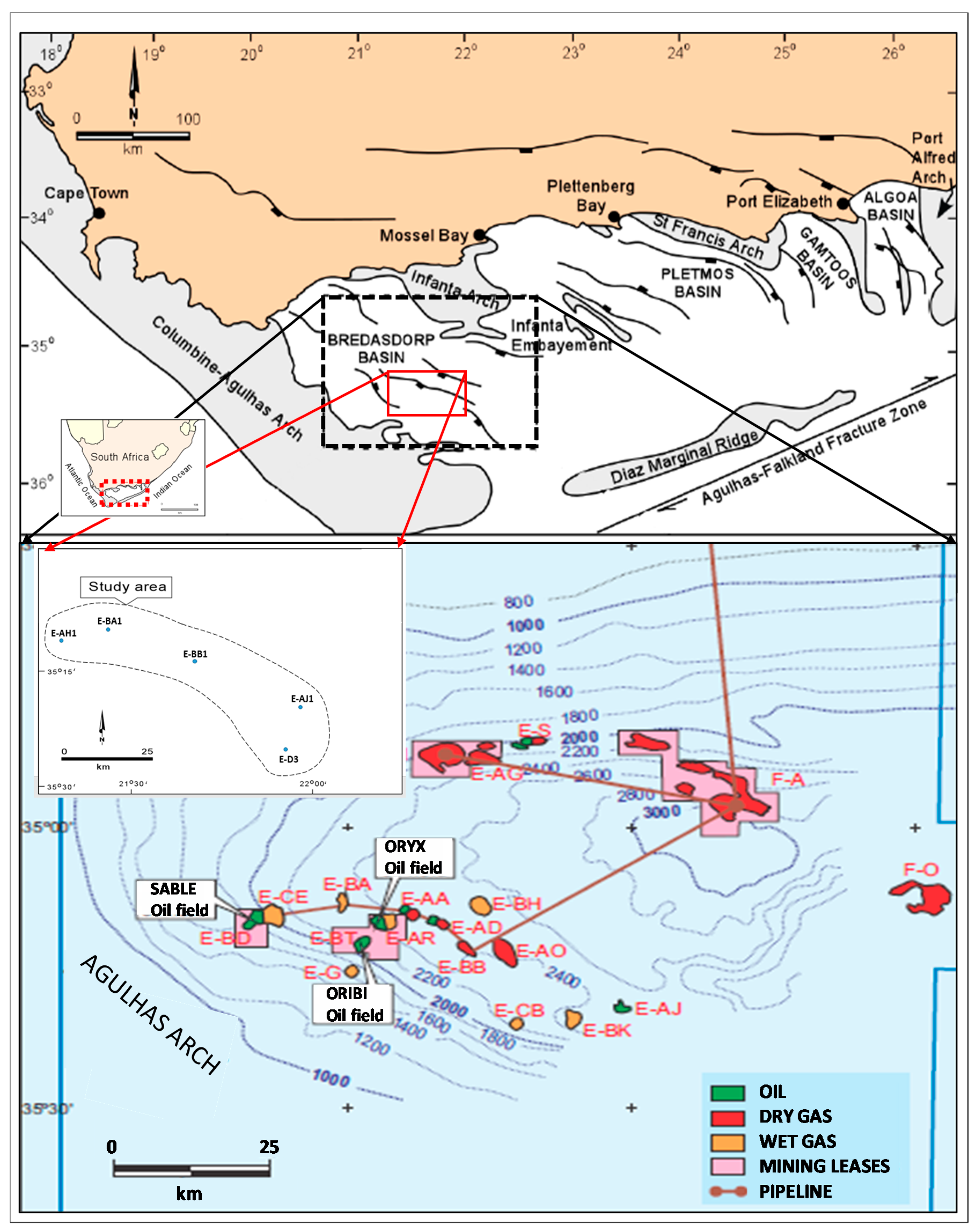
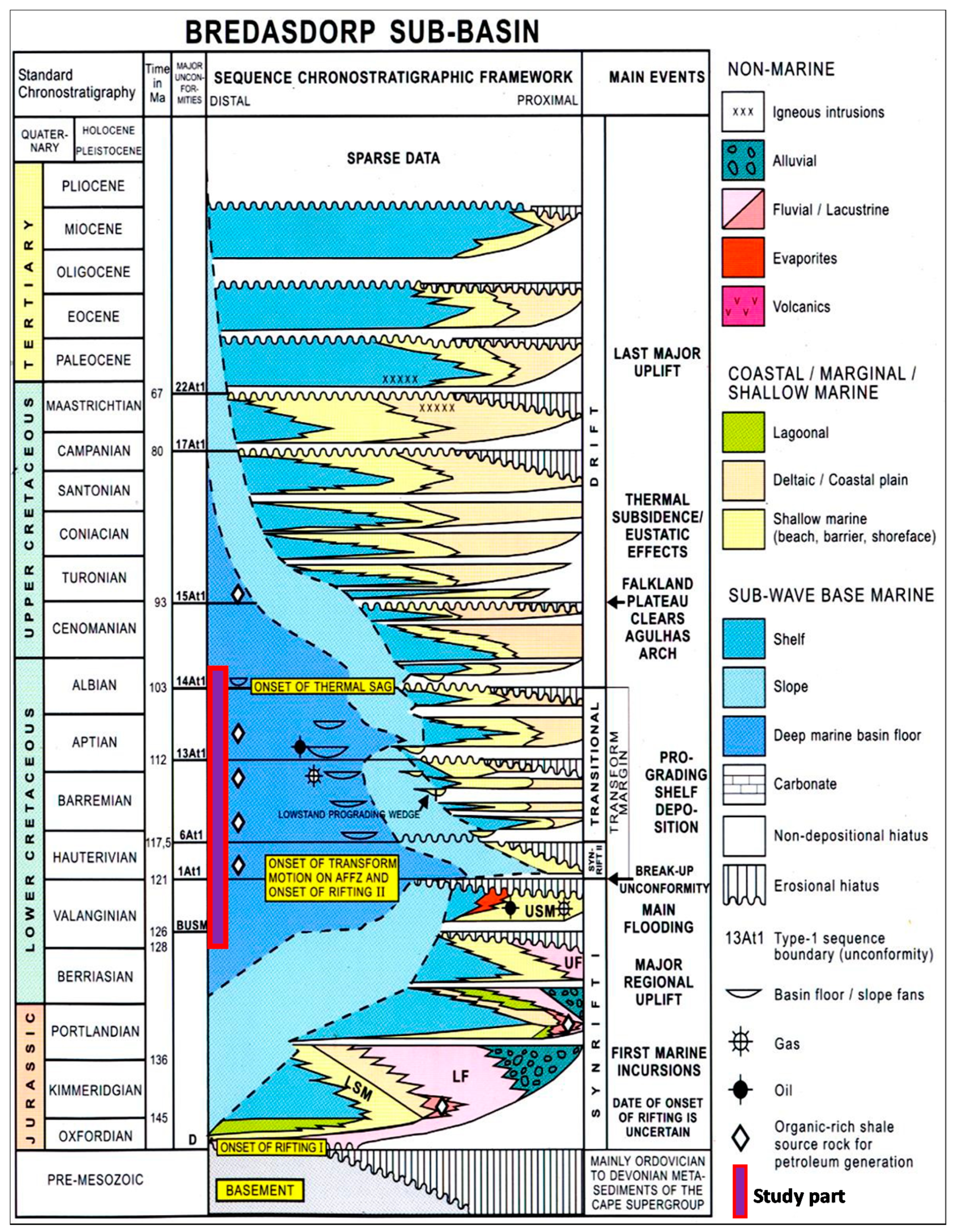
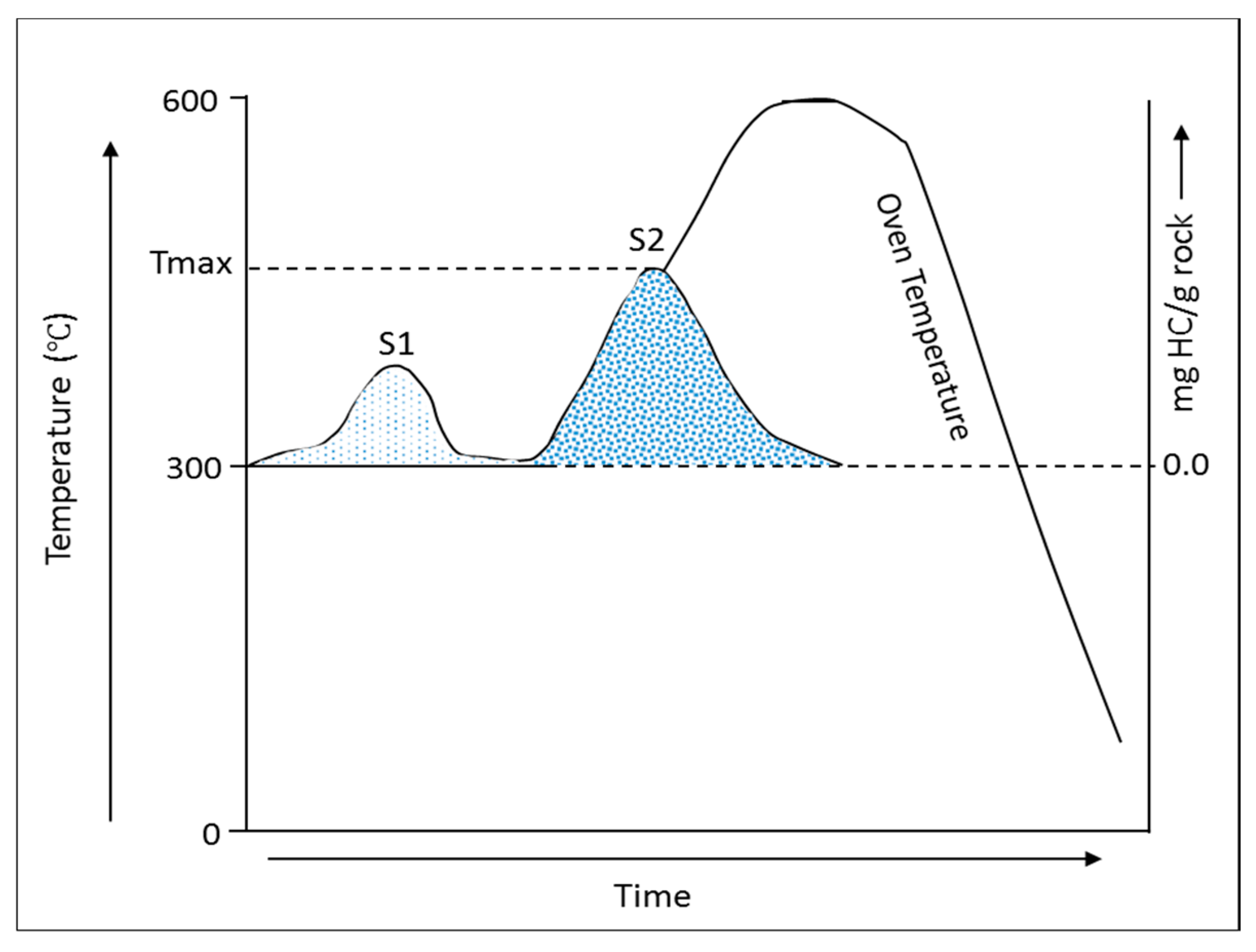
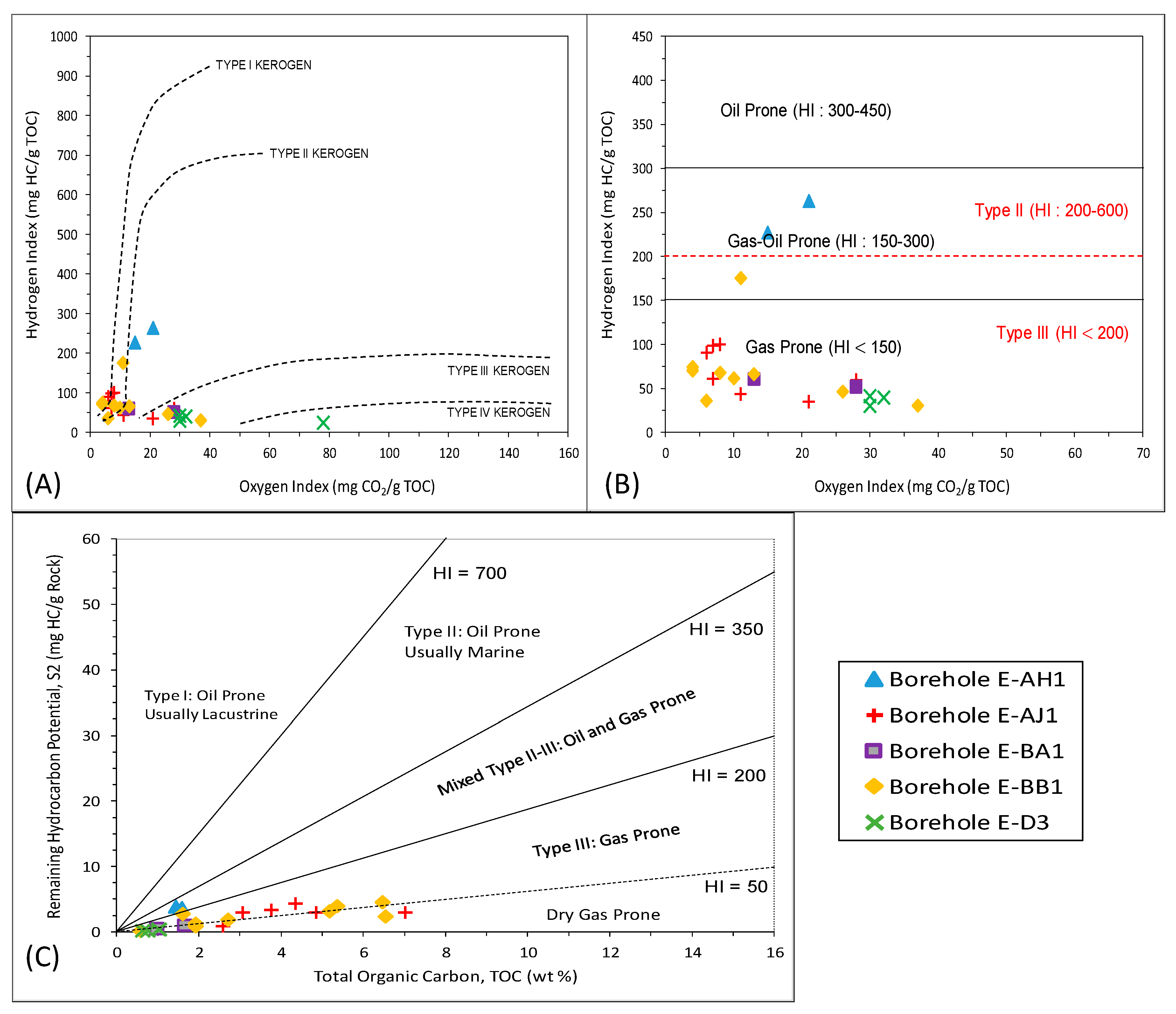
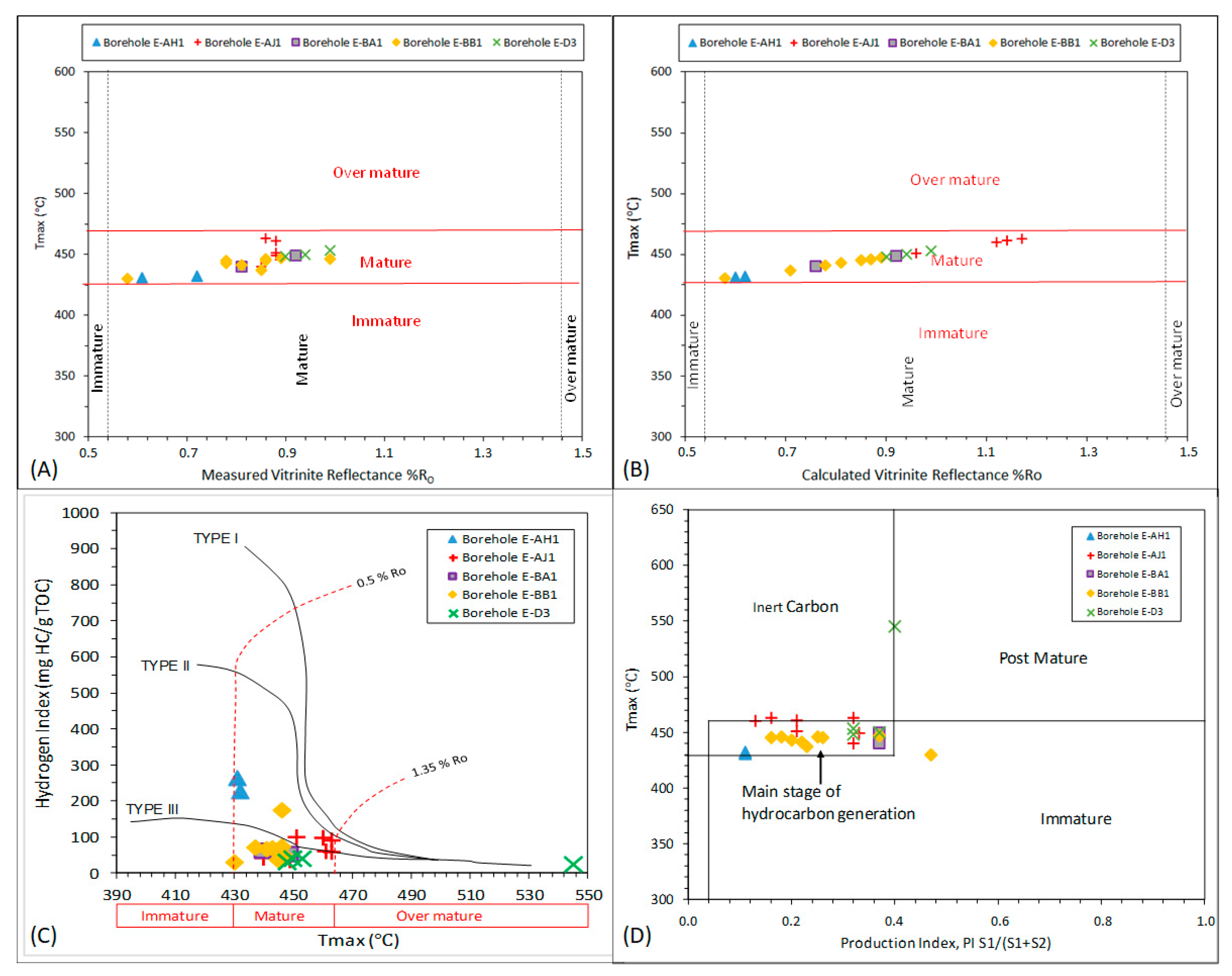
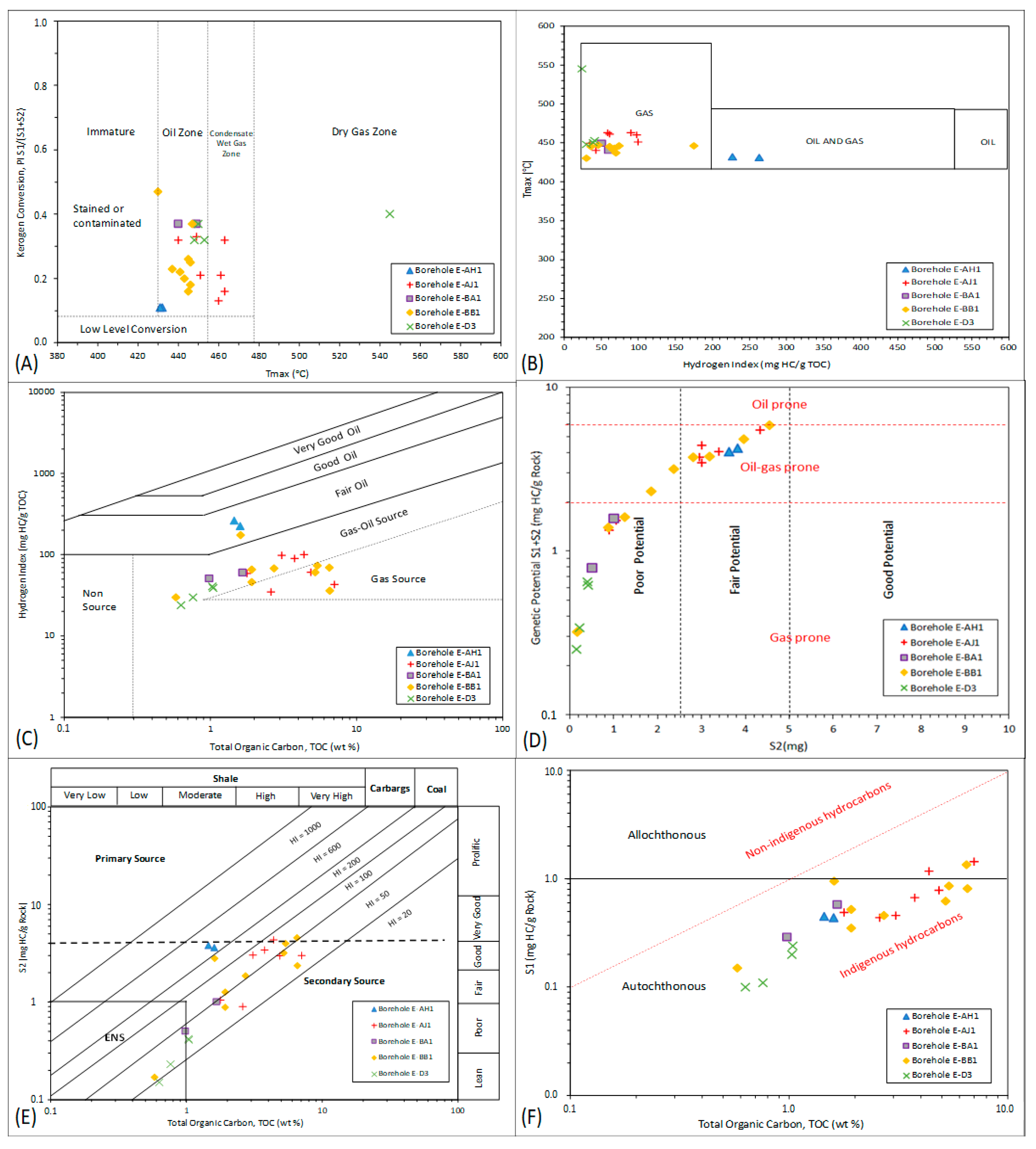
| Measured Parameters |
| Tmax is the maximum generation of hydrocarbons during pyrolysis and is much higher than the temperature governing the formation of hydrocarbons in nature S1 = amount of hydrocarbon that is thermally distilled from the whole rock at temperature 300 °C. Units: mg of hydrocarbon/gram of rock S2 = amount of hydrocarbons liberated through pyrolytic degradation of kerogen between 300 °C and 650 °C. Units: mg of hydrocarbon/gram of rock S3 = amount of organic CO2 liberated between 300 °C and 390 °C. Units: mg of CO2/gram of rock |
| Calculated Parameters |
| SP (hydrocarbon potential) = SP correspond to the total amount of hydrocarbons that the source rock can generate at matured level. PI (production index) = PI is used to characterise the evolution of the organic matter, as PI increases with depth in very fine-grained rocks, also with source rock maturation before hydrocarbon are expelled. HI (hydrogen index) = 100 HI is the amount of hydrogen contained within the kerogen, with higher HI indicating a potential for oil production. OI (oxygen index) = 100 OI is the amount of oxygen in the kerogen and is useful in tracking the maturation path of the kerogen. |
| S/N | Borehole | Depth | Lithology | TOC (wt.%) | S/N | Borehole | Depth | Lithology | TOC (wt.%) | |
|---|---|---|---|---|---|---|---|---|---|---|
| 1 | E-AH1 | 2478.80 | Shale | 0.22 | 43 | E-BA1 | 2843.80 | Sandstone | 0.14 | |
| 2 | E-AH1 | 2479.50 | Shale | 0.31 | 44 | E-BA1 | 2848.60 | Mudstone | 0.98 | |
| 3 | E-AH1 | 2480.00 | Shale | 1.45 | 45 | E-BA1 | 2849.80 | Mudstone | 0.44 | |
| 4 | E-AH1 | 2480.40 | Shale | 0.26 | 46 | E-BB1 | 2541.06 | Mudstone | 0.58 | |
| 5 | E-AH1 | 2480.80 | Shale | 0.41 | 47 | E-BB1 | 2543.00 | Sandstone | 0.39 | |
| 6 | E-AH1 | 2484.00 | Shale | 1.60 | 48 | E-BB1 | 2549.90 | Mudstone | 6.48 | |
| 7 | E-AH1 | 2485.00 | Shale | 0.37 | 49 | E-BB1 | 2550.00 | Shale | 0.49 | |
| 8 | E-AJ1 | 2692.20 | Sandstone | 0.34 | 50 | E-BB1 | 2550.60 | Shale | 0.47 | |
| 9 | E-AJ1 | 2693.00 | Sandstone | 0.30 | 51 | E-BB1 | 2553.00 | Sandstone | 0.42 | |
| 10 | E-AJ1 | 2693,60 | Sandstone | 0.44 | 52 | E-BB1 | 2556.00 | Sandstone | 0.30 | |
| 11 | E-AJ1 | 2694.07 | Sandstone | 1.78 | 53 | E-BB1 | 2662.46 | Sandstone | 1.92 | |
| 12 | E-AJ1 | 2695.80 | Sandstone | 0.21 | 54 | E-BB1 | 2665.00 | Sandstone | 0.47 | |
| 13 | E-AJ1 | 2700.10 | Mudstone | 3.07 | 55 | E-BB1 | 2667.00 | Mudstone | 2.72 | |
| 14 | E-AJ1 | 2707.00 | Mudstone | 3.76 | 56 | E-BB1 | 2720.90 | Sandstone | 6.54 | |
| 15 | E-AJ1 | 2707.30 | Sandstone | 0.47 | 57 | E-BB1 | 2722.93 | Mudstone | 5.19 | |
| 16 | E-AJ1 | 2707.60 | Sandstone | 0.42 | 58 | E-BB1 | 2855.00 | Sandstone | 0.27 | |
| 17 | E-AJ1 | 2708.00 | Sandstone | 0.48 | 59 | E-BB1 | 2872.85 | Mudstone | 5.37 | |
| 18 | E-AJ1 | 2727.40 | Sandstone | 0.44 | 60 | E-BB1 | 2873.60 | Mudstone | 0.38 | |
| 19 | E-AJ1 | 2728.00 | Sandstone | 2.59 | 61 | E-BB1 | 2874.30 | Mudstone | 0.44 | |
| 20 | E-AJ1 | 2728.50 | Sandstone | 0.40 | 62 | E-BB1 | 2875.00 | Mudstone | 0.43 | |
| 21 | E-AJ1 | 2729.10 | Sandstone | 0.29 | 63 | E-BB1 | 2876.80 | Mudstone | 0.46 | |
| 22 | E-AJ1 | 2729.60 | Sandstone | 0.43 | 64 | E-BB1 | 3281.15 | Mudstone | 0.45 | |
| 23 | E-AJ1 | 2730.00 | Sandstone | 0.34 | 65 | E-BB1 | 3283.53 | Mudstone | 1.61 | |
| 24 | E-AJ1 | 2730.20 | Sandstone | 0.44 | 66 | E-BB1 | 3285.00 | Sandstone | 0.44 | |
| 25 | E-AJ1 | 2967.40 | Shale | 0.39 | 67 | E-BB1 | 3286.20 | Sandstone | 0.44 | |
| 26 | E-AJ1 | 2968.20 | Sandstone | 0.30 | 68 | E-BB1 | 3287.00 | Sandstone | 0.41 | |
| 27 | E-AJ1 | 2976.29 | Sandstone | 7.03 | 69 | E-BB1 | 3288.00 | Sandstone | 0.48 | |
| 28 | E-AJ1 | 2978.00 | Sandstone | 0.33 | 70 | E-BB1 | 3289.00 | Sandstone | 0.40 | |
| 29 | E-AJ1 | 2979.50 | Sandstone | 0.38 | 71 | E-BB1 | 3290.00 | Sandstone | 0.43 | |
| 30 | E-AJ1 | 2981.00 | Mudstone | 4.85 | 72 | E-BB1 | 3291.86 | Mudstone | 1.92 | |
| 31 | E-AJ1 | 2983.80 | Shale | 0.48 | 73 | E-D3 | 3260.90 | Mudstone | 1.03 | |
| 32 | E-AJ1 | 2984.00 | Sandstone | 0.41 | 74 | E-D3 | 3262.00 | Shale | 0.49 | |
| 33 | E-AJ1 | 3039.10 | Shale | 4.36 | 75 | E-D3 | 3263.60 | Mudstone | 1.04 | |
| 34 | E-BA1 | 2828.05 | Mudstone | 1.66 | 76 | E-D3 | 3265.50 | Mudstone | 0.76 | |
| 35 | E-BA1 | 2830.30 | Shale | 0.30 | 77 | E-D3 | 3266.00 | Shale | 0.43 | |
| 36 | E-BA1 | 2830.70 | Shale | 0.32 | 78 | E-D3 | 3267.00 | Sandstone | 0.48 | |
| 37 | E-BA1 | 2831.20 | Shale | 0.29 | 79 | E-D3 | 3268.00 | Sandstone | 0.41 | |
| 38 | E-BA1 | 2831.90 | Shale | 0.41 | 80 | E-D3 | 3269.00 | Sandstone | 0.38 | |
| 39 | E-BA1 | 2832.80 | Shale | 0.30 | 81 | E-D3 | 3270,00 | Shale | 0.40 | |
| 40 | E-BA1 | 2833.20 | Shale | 0.31 | 82 | E-D3 | 3527,66 | Mudstone | 0.63 | |
| 41 | E-BA1 | 2837.90 | Sandstone | 0.24 | 83 | E-D3 | 3740,10 | Shale | 0.39 | |
| 42 | E-BA1 | 2842.30 | Sandstone | 0.17 |
| Kerogen Type | HI (mgHC/g TOC) | S2/S3 (mg) | Atomic H/C | Main Expelled at Peak Maturity |
|---|---|---|---|---|
| I | 600 | 15 | 1.5 | Oil |
| II | 300–600 | 10–15 | 1.2–1.5 | Oil |
| II/III | 200–300 | 5–10 | 1.0–1.2 | Mixed oil and gas |
| III | 50–200 | 1–5 | 0.7–1.0 | Gas |
| IV | 50 | 1 | 0.7 | Dry Gas |
| Quality | TOC (wt.%) | S1 (mg) | S2 (mg) |
|---|---|---|---|
| Poor | 0.0–0.5 | 0.0–0.5 | 0.0–2.5 |
| Fair | 0.5–1.0 | 0.5–1.0 | 2.5–5.0 |
| Good | 1.0–2.0 | 1.0–2.0 | 5.0–10.0 |
| Very good | >2.0 | >2.0 | >100.0 |
| Sample ID | Borehole | Lithology | Depth (m) | LECO TOC (w%) | S1 (mgHC/g) | S2 (mgHC/g) | SP = S1+ S2 (mgHC/g) | S3(mgCO2/g) | Calculated % R (RE Tmax) | HI (S2 × 100/TOC) | OI (S3 × 100/TOC) | S2/S3 Conc. (mg HC/mg CO2) | S1/TOC Norm. Oil Content | Production Index (S1/(S1 + S2)) | |
|---|---|---|---|---|---|---|---|---|---|---|---|---|---|---|---|
| 3 | E-AH1 | Shale | 2480.00 | 1.45 | 0.45 | 3.82 | 4.27 | 0.30 | 431 | 0.60 | 263 | 21 | 13 | 31 | 0.11 |
| 6 | E-AH1 | Shale | 2484.00 | 1.60 | 0.44 | 3.63 | 4.07 | 0.24 | 432 | 0.62 | 227 | 15 | 15 | 28 | 0.11 |
| 11 | E-AJ1 | Sandstone | 2694.07 | 1.78 | 0.49 | 1.05 | 1.54 | 0.50 | 463 | 0.71 | 59 | 28 | 2 | 28 | 0.32 |
| 13 | E-AJ1 | Mudstone | 2700.10 | 3.07 | 0.46 | 3.01 | 3.47 | 0.23 | 460 | 1.12 | 98 | 7 | 13 | 15 | 0.13 |
| 14 | E-AJ1 | Mudstone | 2707.00 | 3.76 | 0.57 | 3.40 | 3.97 | 0.23 | 463 | 1.17 | 90 | 6 | 15 | 18 | 0.16 |
| 19 | E-AJ1 | Sandstone | 2728.00 | 2.59 | 0.44 | 0.90 | 1.34 | 0.55 | 449 | 0.92 | 35 | 21 | 2 | 17 | 0.33 |
| 27 | E-AJ1 | Sandstone | 2976.29 | 7.03 | 1.44 | 3.00 | 4.44 | 0.74 | 440 | 0.76 | 43 | 11 | 4 | 20 | 0.32 |
| 30 | E-AJ1 | Mudstone | 2981.00 | 4.85 | 0.78 | 2.96 | 3.74 | 0.33 | 461 | 1.14 | 61 | 7 | 9 | 16 | 0.21 |
| 33 | E-AJ1 | Shale | 3039.10 | 4.36 | 1.18 | 4.34 | 5.52 | 0.35 | 451 | 0.96 | 100 | 8 | 12 | 27 | 0.21 |
| 34 | E-BA1 | Mudstone | 2828.05 | 1.66 | 0.58 | 1.00 | 1.58 | 0.22 | 440 | 0.76 | 60 | 13 | 5 | 35 | 0.37 |
| 44 | E-BA1 | Mudstone | 2848.00 | 0.98 | 0.29 | 0.50 | 0.79 | 0.27 | 449 | 0.92 | 51 | 28 | 2 | 30 | 0.37 |
| 46 | E-BB1 | Mudstone | 2541.06 | 0.58 | 0.15 | 0.17 | 0.32 | 0.21 | 430 | 0.58 | 30 | 37 | 1 | 26 | 0.47 |
| 48 | E-BB1 | Shale | 2549.90 | 6.48 | 1.35 | 4.55 | 5.90 | 0.26 | 437 | 0.71 | 70 | 4 | 18 | 21 | 0.23 |
| 53 | E-BB1 | Sandstone | 2662.46 | 1.92 | 0.35 | 1.26 | 1.61 | 0.24 | 441 | 0.78 | 66 | 13 | 5 | 18 | 0.22 |
| 55 | E-BB1 | Mudstone | 2667.00 | 2.72 | 0.46 | 1.85 | 2.31 | 0.21 | 443 | 0.81 | 68 | 8 | 9 | 17 | 0.20 |
| 56 | E-BB1 | Sandstone | 2720.90 | 6.54 | 0.81 | 2.36 | 3.17 | 0.40 | 445 | 0.85 | 36 | 6 | 6 | 12 | 0.26 |
| 57 | E-BB1 | Mudstone | 2722.93 | 5.19 | 0.62 | 3.18 | 3.80 | 0.51 | 445 | 0.85 | 61 | 10 | 6 | 12 | 0.16 |
| 59 | E-BB1 | Mudstone | 2872.85 | 5.37 | 0.86 | 3.96 | 4.82 | 0.19 | 446 | 0.87 | 74 | 4 | 21 | 16 | 0.18 |
| 65 | E-BB1 | Mudstone | 3283.53 | 1.61 | 0.95 | 2.81 | 3.76 | 0.17 | 446 | 0.87 | 175 | 11 | 17 | 59 | 0.25 |
| 72 | E-BB1 | Mudstone | 3291.86 | 1.92 | 0.52 | 0.88 | 1.40 | 0.49 | 447 | 0.89 | 46 | 26 | 2 | 27 | 0.37 |
| 73 | E-D3 | Mudstone | 3260.90 | 1.03 | 0.20 | 0.42 | 0.62 | 0.31 | 453 | 0.99 | 41 | 30 | 1 | 19 | 0.32 |
| 75 | E-D3 | Mudstone | 3263.60 | 1.04 | 0.24 | 0.41 | 0.65 | 0.33 | 450 | 0.94 | 39 | 32 | 1 | 23 | 0.37 |
| 76 | E-D3 | Mudstone | 3265.50 | 0.76 | 0.11 | 0.23 | 0.34 | 0.23 | 448 | 1.24 | 30 | 30 | 1 | 15 | 0.32 |
| 82 | E-D3 | Mudstone | 3527.66 | 0.63 | 0.10 | 0.15 | 0.25 | 0.49 | 545 | 2.65 | 24 | 78 | 0.1 | 16 | 0.40 |
| Borehole | Depth (m) | Calculated Vitrinite Reflectance %r | Mean Vitrinite %r (Measured) | Range of Readings %r | Standard Deviation | Photomicrographs of the Dispersed Organic Matter | Observations and Maturity Interpretation |
|---|---|---|---|---|---|---|---|
| E-AH1 | 2480.00 | 0.60 | 0.61 | 0.42–0.79 | 0.132 | 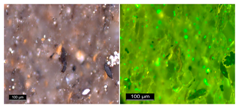 | Very small organic fragments interspersed with silicate minerals. Rare fluorescing liptinite fragments were determined. The sample is mature. |
| E-AH1 | 2484.00 | 0.62 | 0.68 | 0.38–0.98 | 0.177 |  | Small vitrinite fragments and liptinite observed. The sample is mature. |
| E-AJ1 | 2694.07 | 0.71 | 0.60 | 0.50–0.69 | 0.073 | 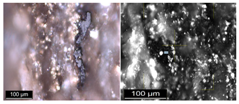 | Small vitrinite fragments and liptinite observed. Occasional, large pieces of organic matter. The sample is mature. |
| E-AJ1 | 2700.10 | 1.12 | 0.72 | 0.5–1.00 | 0.132 |  | Distinct band of organic matter like fusinite and semifusinite band, not fragmented, but cracked. Vitrinite particles were limited, and those measured provided low values. The sample is mature. |
| E-AJ1 | 2707.00 | 1.17 | 0.81 | 0.6–1.02 | 0.117 | 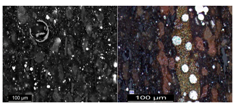 | Vitrinite and liptinite observed, and alteration minerals, with lots of organic fragments and framboidal pyrite bands. The sample is mature. |
| E-AJ1 | 2728.00 | 0.92 | 0.85 | 0.65–1.05 | 0.105 |  | Narrow strip of coal in the sample block. The coal was dominated by altered organic matter. Rare vitrinite was embedded in the altered organic material. Zircons were observed as well as large pyrite. The sample is mature. |
| E-AJ1 | 2976.29 | 0.76 | 0.88 | 0.66–1.07 | 0.14 | 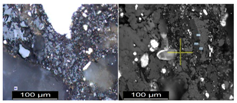 | Mostly quartz with stingers of organic matter and darker vitrinite bands between inertinite bands. The sample is mature. |
| E-AJ1 | 2981.00 | 1.14 | 0.88 | 0.65–1.10 | 0.125 | 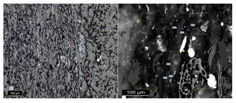 | Very thin dark organic bands, with less organic matter compared to other samples. Fusinite and vitrinite particles are obvious. The sample is mature. |
| E-AJ1 | 3039.10 | 0.96 | 0.90 | 0.60–1.20 | 0.155 | 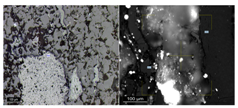 | Lots of large vitrinite bands and large fusinite packed into a thin band in the sample. The sample is mature. |
| E-BA1 | 2828.05 | 0.76 | 0.75 | 0.40–1.09 | 0.181 | 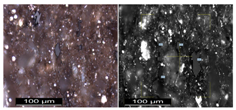 | The sample contains a high proportion of vitrinite fragments, and framboidal pyrite band. The sample is mature. |
| E-BB1 | 2667.00 | 0.81 | 0.76 | 0.46–1.06 | 0.122 | 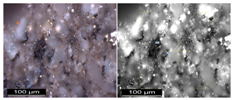 | Lots of fragmented organic matter observed and few vitrinite particles. The sample is mature. |
| E-BB1 | 2541.06 | 0.71 | 0.78 | 0.55–1.00 | 0.092 | 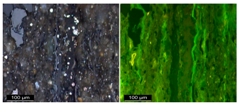 | Vitrinite and liptinite were observed and limited pyrite. The sample is mature. |
| E-BB1 | 2720.90 | 0.85 | 0.78 | 0.55–1.00 | 0.105 |  | Distinct organic matter bands and vitrinite are obvious in the sample. The sample is mature. |
| E-BB1 | 2722.93 | 0.87 | 0.78 | 0.50–1.05 | 0.121 | 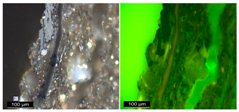 | Moderate organic matter, large pieces of liptinite and vitrinite observed. The sample is mature. |
| E-BB1 | 2872.85 | 0.87 | 0.79 | 0.52–1.06 | 0.145 |  | High proportion of suitable vitrinite particles, along with large fusinite particles. The sample is mature. |
| E-BB1 | 2549.90 | 0.85 | 0.80 | 0.6–1.00 | 0.093 | 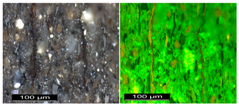 | Small vitrinite fragments; liptinite and banded fragments of organic matter were observed. The sample is mature. |
| E-BB1 | 2662.46 | 0.78 | 0.82 | 0.59–1.05 | 0.127 | 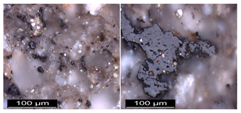 | A relatively high proportion of fusinite and vitrinite was observed primarily as very fine fragments compressed between quartz grains. The sample is mature. |
| E-BB1 | 3291.86 | 0.89 | 0.96 | 0.77–1.15 | 0.086 |  | Limited organic matter with lots of fine pyrite. The sample is mature. |
| E-D3 | 3263.60 | 0.94 | 0.90 | 0.69–1.10 | 0.174 | 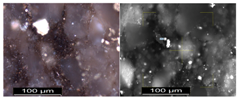 | Very fine organic matter dispersed between quartz grains. The sample is mature. |
© 2020 by the authors. Licensee MDPI, Basel, Switzerland. This article is an open access article distributed under the terms and conditions of the Creative Commons Attribution (CC BY) license (http://creativecommons.org/licenses/by/4.0/).
Share and Cite
Baiyegunhi, T.L.; Liu, K.; Gwavava, O.; Wagner, N.; Baiyegunhi, C. Geochemical Evaluation of the Cretaceous Mudrocks and Sandstones (Wackes) in the Southern Bredasdorp Basin, Offshore South Africa: Implications for Hydrocarbon Potential. Minerals 2020, 10, 595. https://doi.org/10.3390/min10070595
Baiyegunhi TL, Liu K, Gwavava O, Wagner N, Baiyegunhi C. Geochemical Evaluation of the Cretaceous Mudrocks and Sandstones (Wackes) in the Southern Bredasdorp Basin, Offshore South Africa: Implications for Hydrocarbon Potential. Minerals. 2020; 10(7):595. https://doi.org/10.3390/min10070595
Chicago/Turabian StyleBaiyegunhi, Temitope Love, Kuiwu Liu, Oswald Gwavava, Nicola Wagner, and Christopher Baiyegunhi. 2020. "Geochemical Evaluation of the Cretaceous Mudrocks and Sandstones (Wackes) in the Southern Bredasdorp Basin, Offshore South Africa: Implications for Hydrocarbon Potential" Minerals 10, no. 7: 595. https://doi.org/10.3390/min10070595
APA StyleBaiyegunhi, T. L., Liu, K., Gwavava, O., Wagner, N., & Baiyegunhi, C. (2020). Geochemical Evaluation of the Cretaceous Mudrocks and Sandstones (Wackes) in the Southern Bredasdorp Basin, Offshore South Africa: Implications for Hydrocarbon Potential. Minerals, 10(7), 595. https://doi.org/10.3390/min10070595





